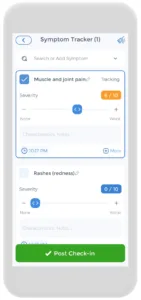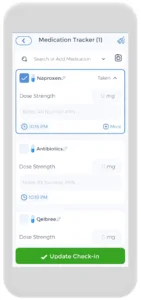
Are you familiar with the saying “walking on glass?” For the millions of people worldwide who suffer from gout, it’s not just a figure of speech – it’s a daily reality. Gout is a type of arthritis that causes sudden and excruciating pain, swelling, and redness in the joints. When there is too much uric acid in the blood, they can form sharp crystals that settle in the joints, leading to intense pain and inflammation. And when these attacks occur, they can last for days, weeks, or even longer, making it difficult to walk, work, or enjoy life.
In this article, we’ll explore the ins and outs of gout and gout flare ups, including what causes them, how they’re treated, and what you can do to prevent them. Whether you’re experiencing gout symptoms yourself or are looking to learn more about this painful condition, read on to discover everything you need to know about gout and flare ups.
Gout: Understanding the Basics
Gout is a type of arthritis that is characterized by the deposition of uric acid crystals in the joints and soft tissues, leading to painful joint inflammation. It is a common condition that affects millions of people worldwide, and its prevalence has been increasing in recent years due to changes in lifestyle and dietary habits.
tissues, leading to painful joint inflammation. It is a common condition that affects millions of people worldwide, and its prevalence has been increasing in recent years due to changes in lifestyle and dietary habits.
In the United States, gout affects approximately 8.3 million people, or 4% of the population. It is the most common form of inflammatory arthritis in men over the age of 40, and its incidence is increasing in women, particularly after menopause.
Gout is more prevalent in men than women, with men being three to four times more likely to develop the condition than women. This is because men have higher levels of uric acid in their blood than women, and uric acid levels increase with age in both sexes. Men are also more likely to consume alcohol and high-purine foods, which can raise uric acid levels and trigger gout attacks.
Gout is more common in older adults, particularly those over the age of 60. However, it can affect people of all ages, including children and adolescents. In addition to age, other risk factors for gout include obesity, high blood pressure, diabetes, and a family history of the condition.
Overall, gout is a common and increasingly prevalent form of arthritis that can significantly impact health conditions and a person’s quality of life. However, with proper diagnosis and management, gout can be effectively treated, and its symptoms can be minimized.
Why does gout occur?
Gout occurs as a result of the abnormal metabolism of purines, which are substances found in many foods and are also produced naturally by the body. When purines are broken down, they form uric acid, which is a waste product that is normally filtered out of the body by the kidneys and excreted in the urine.
However, in people with gout, there is either an overproduction of uric acid or a reduced ability of the kidneys to eliminate it, leading to a buildup of too much uric acid in the bloodstream. This condition, known as hyperuricemia, is a key risk factor to develop gout.
When too much uric acid in the blood, the excess uric acid can form crystals that accumulate in the joints and surrounding tissues. These sharp, needle-like crystals trigger an inflammatory response in affected joints, leading to the characteristic symptoms of gout, such as severe pain and swelling, swelling, and redness in the affected joint.
Gout attacks often occur suddenly and can be triggered by a range of factors, including diet, alcohol consumption, dehydration, certain medications, and underlying medical conditions. Over time, repeated gout attacks can cause damage to the affected joints and lead to chronic joint pain and disability.
How is gout diagnosed?
To diagnose gout, your doctor may perform a physical examination, review your medical history, and order blood tests to measure your uric acid levels. They may also perform imaging tests, such as X-rays, to check for joint damage and rule out other conditions with similar symptoms.
What conditions can cause gout?
Certain medical conditions and lifestyle factors can increase your risk of developing gout. These include:
- Genetics: Gout tends to run in families, so if you have a family history of gout, you may be at a higher risk of developing it.
- Obesity: Being overweight or obese increases your risk of developing gout, as excess body weight can lead to higher levels of uric acid in the blood.
- Diet: Eating foods that are high in purines, such as red meat, shellfish, and organ meats, can cause too much uric acid and trigger gout.
- Alcohol: Drinking alcohol, particularly beer, can increase uric acid levels and trigger gout.
- Certain medications: Medications such as diuretics and aspirin can increase uric acid levels and trigger gout.
How is gout treated?
The treatment of gout typically involves both medications to manage acute symptoms during a gout attack and long-term medications and lifestyle modifications to prevent future attacks and reduce the risk of joint damage.
 During an acute gout attack, medications such as nonsteroidal anti-inflammatory drugs (NSAIDs), colchicine, and corticosteroids can be used to reduce pain and inflammation. NSAIDs, such as ibuprofen or naproxen, are commonly used to relieve pain and inflammation during a gout attack. Colchicine is an anti-inflammatory medication that can be used to treat recurrent gout attacks, but it has side effects such as gastrointestinal discomfort, so it is typically used in lower doses or for shorter periods. Corticosteroids, such as prednisone, can be used to manage severe gout attacks and are often given in the form of an injection into the affected joint or muscle.
During an acute gout attack, medications such as nonsteroidal anti-inflammatory drugs (NSAIDs), colchicine, and corticosteroids can be used to reduce pain and inflammation. NSAIDs, such as ibuprofen or naproxen, are commonly used to relieve pain and inflammation during a gout attack. Colchicine is an anti-inflammatory medication that can be used to treat recurrent gout attacks, but it has side effects such as gastrointestinal discomfort, so it is typically used in lower doses or for shorter periods. Corticosteroids, such as prednisone, can be used to manage severe gout attacks and are often given in the form of an injection into the affected joint or muscle.
For long-term treatment of chronic gout, medications that lower uric acid levels are often prescribed to treat gout. These medications, such as allopurinol, febuxostat, and probenecid, work by reducing the production of uric acid in the body or increasing the excretion of uric acid through the kidneys. These medications can take several weeks to achieve their full effect and may need to be taken for life to prevent a gout attack and joint damage.
In addition to medication, lifestyle modifications can also be helpful in managing gout. Maintaining a healthy weight through diet and exercise can help to reduce the risk of gout, as obesity is a risk factor for the condition. Limiting alcohol consumption and avoiding high-purine foods, such as red meat, organ meats, and seafood, can also help to prevent gout flare-ups. Drinking plenty of water and staying hydrated can also help to flush excess uric acid out of the body.
Gout Flare Up: A Painful Exacerbation
A gout flare up, also known as an acute gout attack, is a sudden onset of intense joint pain and swelling, and redness in the affected joint. Gout flares occur in gout patients when urate crystals accumulate in the joint and cause inflammation. These attacks typically last several days to a few weeks and can be very painful.
Why do gout flare ups occur?
Gout flares occur when there is an increase in the level of uric acid in the blood. Factors that can trigger a gout flare up include:
- Eating purine rich foods: Purines are natural compounds found in many foods. When the body breaks down purines, it produces uric acid as a waste product. Foods that are high in purines, such as red meat, organ meats, seafood, and alcohol, can increase uric acid levels, increasing production of uric acid crystals in the blood and trigger a gout flare up. It is important to limit a diet rich in these foods to prevent gout flares.
- Dehydration or inadequate fluid intake: When the body is dehydrated, it cannot effectively flush out uric acid, leading to a buildup of uric acid in the blood and potentially triggering a gout attack. Drinking plenty of water and staying hydrated can help prevent gout flare ups.
- Surgery or trauma to the affected joint: Surgery or trauma to the affected joint can cause an increase in inflammation, which can trigger a gout flare up. It is important to protect the affected joint and avoid any unnecessary stress or injury.
- Certain medications: Certain medications, such as diuretics or aspirin, can increase uric acid levels in the blood and potentially trigger a gout flare up. It is important to discuss any medications you are taking with your doctor and make sure they are not contributing to gout flare ups.
- Illness or infection: Illness or infection can cause an increase in inflammation and stress on the body, which can trigger a gout flare up. It is important to take care of your overall health and seek medical attention if you become ill or have an infection to prevent gout flare ups.
Where Do Gout Flare Ups Commonly Occur?
Gout flare ups typically occur in the joints of the feet, especially the big toe, but can also affect other joints such as the ankles, knees, elbows, and wrists. The affected joint may feel warm to the touch, appear swollen and red, and be extremely tender and painful.
Gout flare up and arthritis
While gout is a form of arthritis, there are some notable differences between gout attacks and other types of chronic arthritis and autoimmune diseases like rheumatoid arthritis.
Similarities:
- Pain and inflammation: Both gout attacks and other forms of arthritis are characterized by pain and inflammation in the joints.
- Joint damage: Over time, both gout and other types of arthritis can cause joint damage if left untreated.
Differences:
- Causes: Gout is caused by a buildup of uric acid in the blood, while other types of arthritis may be caused by a variety of factors, such as autoimmune disorders or wear and tear on the joints.
- Joints affected: Gout most commonly affects the big toe, but can also affect other joints such as the ankle, knee, wrist, and fingers. Other forms of arthritis can affect a wide range of joints throughout the body.
- Onset and duration of symptoms: Gout flare ups typically occur suddenly and last for several days to a few weeks, while other types of arthritis may develop gradually and cause chronic pain and stiffness.
- Treatment: The treatment for gout attacks typically involves medications to reduce pain and inflammation, and lifestyle changes to manage uric acid levels. Treatment for other forms of arthritis may involve a combination of medications, physical therapy, and lifestyle modifications.
How to prevent gout flare ups
Preventing gout flare ups is an important part of managing the condition. Here are some additional tips to help prevent gout attacks:
- Maintaining a healthy weight: Being overweight or obese can increase the risk of gout and make gout symptoms worse. Losing weight through a healthy diet and exercise can help manage uric acid levels and prevent flare ups.
- Drinking plenty of water: Staying hydrated can help flush excess uric acid out of the body and prevent the formation of uric acid crystals in the joints. Aim to drink at least 8 glasses of water a day.
- Limiting alcohol intake: Alcohol can increase uric acid levels in the body and trigger gout flare ups. If you do choose to drink, limit your intake to no more than 1-2 drinks per day.
- Avoiding high-purine foods: Certain foods high in purines, such as red meat, organ meats, and seafood, can increase uric acid levels and trigger gout flare ups. Limiting your intake of these foods can help prevent gout attacks.
- Taking medications as prescribed: Long-term treatment for gout may involve medications that lower uric acid levels, such as allopurinol or febuxostat. It’s important to take these medications as prescribed to prevent gout flare ups.
- Avoiding dehydration and injury to the affected joint: Dehydration and injury can both increase the risk of gout flare ups. Be sure to stay hydrated and avoid activities that can cause injury to the affected joint.
What are some management techniques for gout flare ups?
If a gout attack does occur, there are several pain management techniques that can help to alleviate symptoms and speed up recovery. These include:
symptoms and speed up recovery. These include:
- Resting the affected joint and avoiding activities that exacerbate pain
- Applying ice to the affected joint to reduce swelling and pain
- Taking medications as prescribed, such as nonsteroidal anti-inflammatory drugs (NSAIDs), colchicine, or corticosteroids, to reduce pain and inflammation
- Elevating the affected joint to reduce swelling
- Drinking plenty of fluids to stay hydrated and flush out uric acid
In severe cases, a healthcare provider may need to drain fluid from the affected one joint or recommend physical therapy to help the joint restore range of motion and reduce the risk of future flare ups.
Seek treatment if serious
Untreated gout can have serious health consequences. Here are some of the potential dangers of leaving gout untreated:
- Permanent Joint damage: Gout flare ups can cause severe inflammation in the affected joint, leading to damage over time. If left untreated, the damage can become permanent and lead to disability.
- Kidney stones: Uric acid can also accumulate in the kidneys, leading to the formation of kidney stones. These stones can cause intense pain and may require medical intervention to remove.
- Kidney disease: Over time, high levels of uric acid in the blood can also lead to chronic kidney disease, which can have serious health consequences.
- Cardiovascular disease: Studies have shown that people with gout are at an increased risk of developing cardiovascular disease, which can lead to heart attack or stroke.
- Insomnia: The pain and discomfort of gout flare ups can also lead to insomnia, which can have negative effects on overall health and wellbeing.
It’s important to seek medical treatment for gout and to follow a treatment plan to manage symptoms and prevent complications.[3][4][5]
Using an App to Help Manage Gout Attack
Having a gout flare up plan is crucial, and the CareClinic app can help with that. You can use the app as your gout diary. Just go to the diary section of the app and enter your daily symptoms, medications, and triggers as they occur. There are also specific sections on the app to track each of these. Next time you visit the doctor, this information will be handy in your pocket.
The app also has a medication section where you can precisely track the doses you are taking and receive reminders on when to take each medication. We know how difficult but important keeping track of your medications is, so we hope to make it as easy and streamlined as possible.
In conclusion, gout flare ups can be a painful and debilitating condition that affects millions of people worldwide. It is important to understand the causes and triggers of gout flare ups, as well as how to manage and prevent them through lifestyle changes and proper medical treatment. If you suspect that you may have gout or are experiencing a flare up, it is important to speak with your healthcare provider for proper diagnosis and treatment. Don’t let gout control your life – take control of your health and take steps to prevent flare ups today.
Sources:
- Arthritis Foundation. (2021). Gout. Retrieved from https://www.arthritis.org/diseases/gout.
- Centers for Disease Control and Prevention. (2020). Gout. Retrieved from https://www.cdc.gov/arthritis/basics/gout.html.
- Mayo Clinic. (2021). Gout. Retrieved from https://www.mayoclinic.org/diseases-conditions/gout/symptoms-causes/syc-20372897.
- Zhang, Y., & Neogi, T. (2011). Gout: a review of etiology and management. Journal of clinical rheumatology, 17(2), 69-77.
References
- “Gout | Arthritis | CDC”. https://www.cdc.gov/arthritis/gout/index.html
- “Gout: Symptoms, Treatment & Prevention”. https://my.clevelandclinic.org/health/diseases/4755-gout
- “Gout – Symptoms and causes – Mayo Clinic”. https://www.akamai.mayoclinic.org/diseases-conditions/gout/symptoms-causes/syc-20372897
- “Gout | Johns Hopkins Medicine”. https://www.hopkinsmedicine.org/health/conditions-and-diseases/gout/
- “Gout Symptoms, Causes & Diet Recommendations | NIAMS”. https://www.niams.nih.gov/health-topics/gout
- “JMIR mHealth and uHealth – Association Between User Engagement of a Mobile Health App for Gout and Improvements in Self-Care Behaviors: Randomized Controlled Trial”. https://mhealth.jmir.org/2019/8/e15021/
- “Can Smartphone Notifications Help With Gout Management? A Feasibility Study – PubMed”. https://pubmed.ncbi.nlm.nih.gov/37967906/


